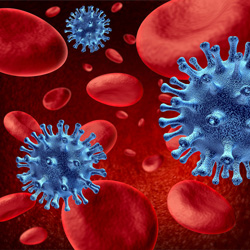Setting up cellular blocks to viral infection
Death from Lassa virus (LASV) infection happens without any antiviral immune response having taken place. This means the disease kills humans by attacking host cell functioning on the strength of the virus itself, rather than eliciting an (ineffective) immune response. The interaction of Lassa virus with its cellular receptor alpha-dystroglycan' (Lassa virus receptor) is a project that has set out to understand more about this disease by analysing the interaction between a virus and its host cells. The first step of virus infection takes place when a virus binds to its cellular receptor(s). Improved understanding of how this happens may highlight how the process can be a promising target for therapeutic intervention. Alpha-dystroglycan (alpha-DG), crucial to normal cell functioning, is the cellular receptor for LASV. Lassa virus receptor partners have already shown that alpha-DG's involvement in cellular signalling results in the recruitment of cellular proteins that are found on the MAP kinase (MEK/ERK) signalling pathway. Specifically, these are the adaptor protein grb2 and the protein kinase MEK1. Further tests on signalling showed that LASV binding disrupted activation of the MEK/ERK pathway via beta1-integrins. These integrin subunits are receptors spanning the plasma membrane that mediate attachment between a cell and surrounding material. Other Lassa virus receptor studies have so far shown that the protein kinase inhibitors staurosporin and genistein effectively block LASV entry. Also, a first screening of protein kinases associated with DG and LASV binding and entry revealed several candidates that actually reduced infection with LASV. One of these is the phosphoinositide-3 kinase (PI3K). Others are still undergoing validation. The Lassa virus receptor project has succeeded in its first aim and revealed the major impact that LASV binding has on DG-mediated signalling in the host cell. Considering the alteration in normal signalling crosstalk between DG and beta1-integrins, project partners believe this signalling equilibrium is what may contribute to development of this deadly disease. This line of discovery is bound to help in future efforts to develop novel therapeutic strategies.







